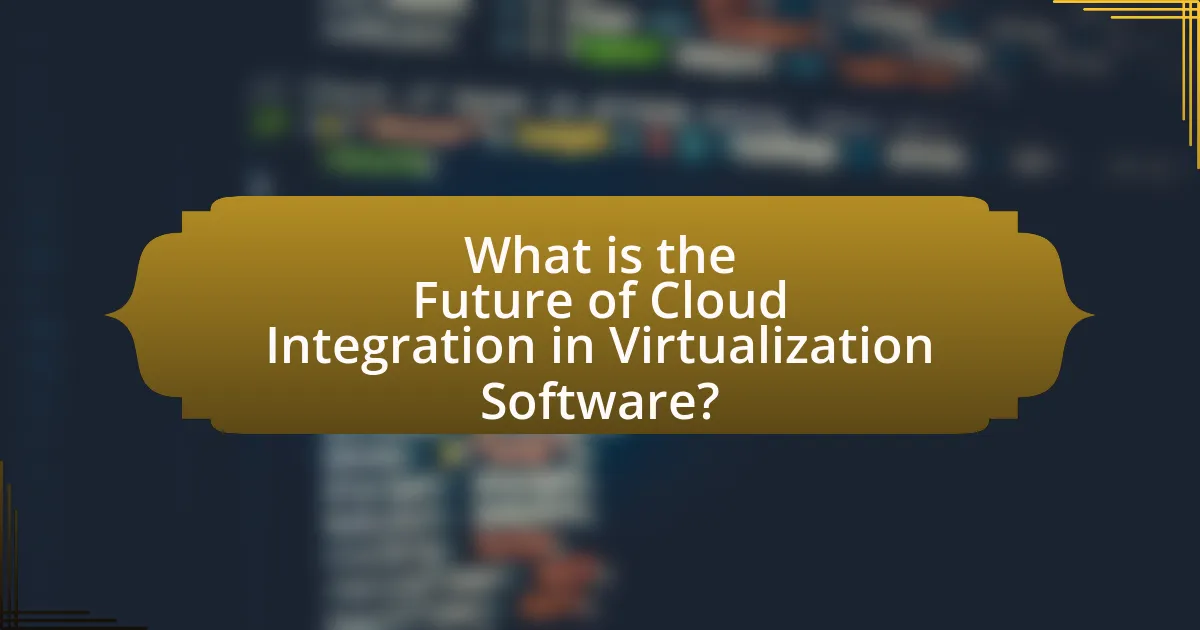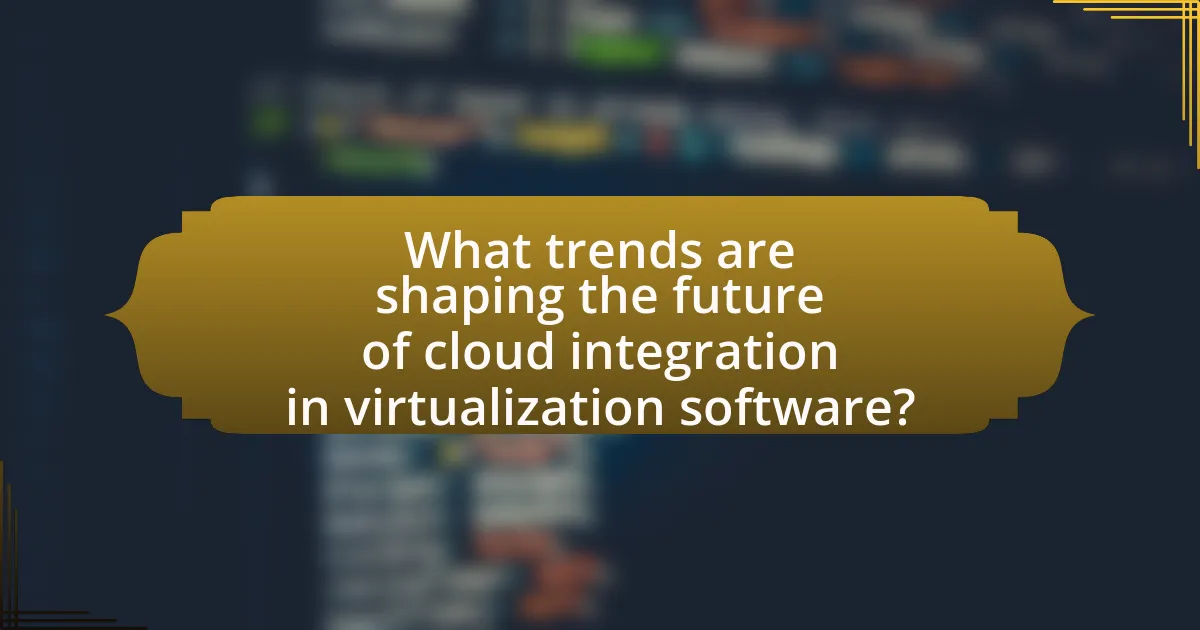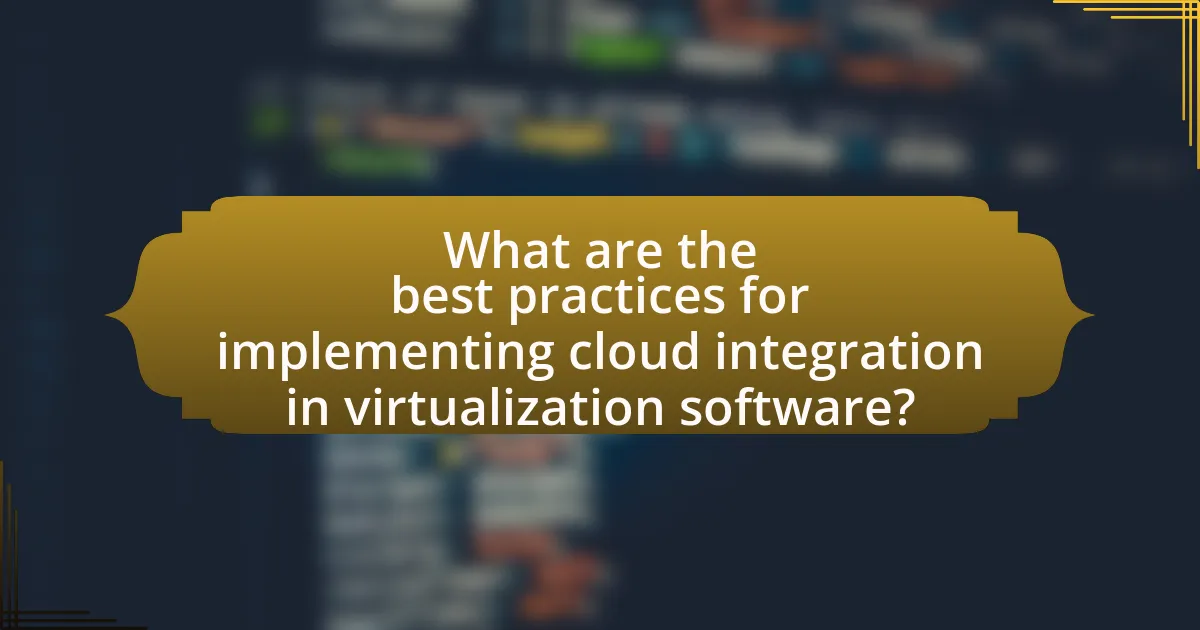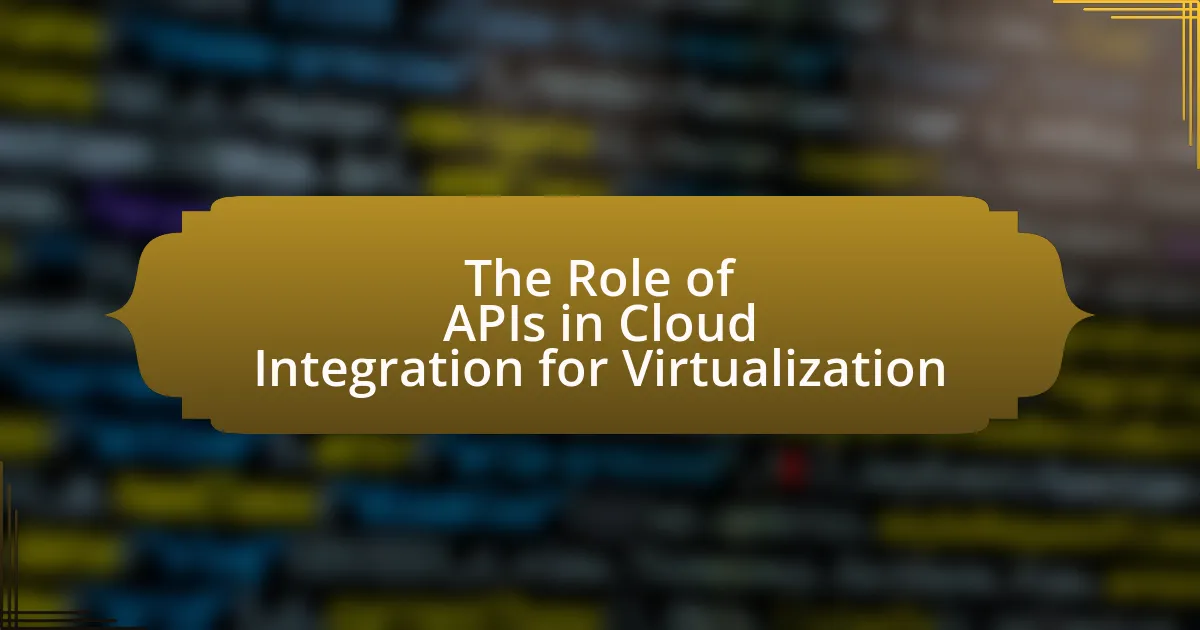The article focuses on the future of cloud integration in virtualization software, highlighting trends such as increased interoperability, scalability, and automation. It discusses how cloud integration transforms virtualization by enabling seamless resource sharing and enhancing operational efficiency, driven by technologies like containerization, microservices, and serverless computing. Key insights include the importance of cloud integration for cost optimization, the role of AI and machine learning in improving resource allocation, and the challenges organizations face, such as data security and interoperability. Additionally, it outlines best practices for implementing cloud integration and recommends tools and platforms that facilitate effective virtualization solutions.
What is the Future of Cloud Integration in Virtualization Software?

The future of cloud integration in virtualization software is characterized by increased interoperability, scalability, and automation. As organizations increasingly adopt hybrid and multi-cloud environments, virtualization software will evolve to seamlessly integrate with various cloud services, enabling efficient resource management and deployment. According to a report by Gartner, by 2025, 85% of organizations will adopt a cloud-first principle, driving the demand for virtualization solutions that can effectively bridge on-premises and cloud resources. This trend will lead to enhanced capabilities in workload migration, disaster recovery, and cost optimization, ultimately transforming how businesses leverage IT infrastructure.
How is cloud integration transforming virtualization software?
Cloud integration is transforming virtualization software by enabling seamless connectivity and resource sharing across diverse environments. This transformation allows virtualization platforms to leverage cloud resources for enhanced scalability, flexibility, and cost efficiency. For instance, organizations can dynamically allocate virtual machines and storage from cloud providers, optimizing resource utilization and reducing on-premises infrastructure costs. According to a report by Gartner, 70% of enterprises are expected to adopt hybrid cloud strategies by 2025, highlighting the growing reliance on cloud integration to enhance virtualization capabilities.
What are the key technologies driving this transformation?
Key technologies driving the transformation in cloud integration within virtualization software include containerization, microservices architecture, and serverless computing. Containerization, exemplified by technologies like Docker and Kubernetes, allows for efficient deployment and management of applications across various environments, enhancing scalability and resource utilization. Microservices architecture enables the development of applications as a suite of small, independent services, facilitating continuous integration and deployment. Serverless computing, represented by platforms such as AWS Lambda, abstracts infrastructure management, allowing developers to focus on code while automatically scaling applications based on demand. These technologies collectively enhance flexibility, efficiency, and responsiveness in cloud environments, supporting the evolving needs of businesses.
How does cloud integration enhance virtualization capabilities?
Cloud integration enhances virtualization capabilities by enabling seamless resource allocation and management across multiple environments. This integration allows virtual machines to access cloud resources dynamically, improving scalability and flexibility. For instance, organizations can quickly provision additional virtual machines in response to increased demand without the need for physical hardware upgrades. Furthermore, cloud integration facilitates centralized management of virtual environments, streamlining operations and reducing overhead costs. This is evidenced by a report from Gartner, which indicates that businesses leveraging cloud-integrated virtualization can achieve up to 30% cost savings in IT operations.
Why is cloud integration important for virtualization software?
Cloud integration is important for virtualization software because it enhances scalability, flexibility, and resource optimization. By integrating cloud services, virtualization software can dynamically allocate resources based on demand, allowing organizations to efficiently manage workloads and reduce costs. For instance, a study by Gartner indicates that organizations leveraging cloud integration with virtualization can achieve up to 30% cost savings in IT infrastructure. This integration also facilitates seamless data access and collaboration across distributed environments, which is crucial for modern enterprises.
What advantages does cloud integration provide to businesses?
Cloud integration provides businesses with enhanced flexibility, scalability, and cost efficiency. By leveraging cloud services, organizations can easily adjust their resources based on demand, allowing for rapid scaling without significant upfront investments. According to a report by Gartner, companies that adopt cloud integration can reduce IT costs by up to 30% while improving operational efficiency. Additionally, cloud integration facilitates seamless data sharing and collaboration across departments and locations, which enhances productivity and decision-making processes.
How does it improve operational efficiency and scalability?
Cloud integration in virtualization software improves operational efficiency and scalability by enabling seamless resource allocation and management across multiple environments. This integration allows organizations to dynamically adjust their computing resources based on demand, reducing idle capacity and optimizing performance. For instance, a study by Gartner indicates that businesses leveraging cloud integration can achieve up to 30% cost savings in IT operations due to improved resource utilization. Additionally, the scalability offered by cloud integration facilitates rapid deployment of applications and services, allowing organizations to respond quickly to market changes and customer needs. This adaptability is crucial in today’s fast-paced business landscape, where the ability to scale operations efficiently can significantly impact competitiveness and growth.
What trends are shaping the future of cloud integration in virtualization software?

The future of cloud integration in virtualization software is being shaped by trends such as increased adoption of hybrid cloud environments, enhanced automation through AI and machine learning, and a focus on security and compliance. Hybrid cloud environments allow organizations to leverage both public and private clouds, facilitating greater flexibility and scalability. Automation technologies, driven by AI and machine learning, streamline integration processes, reduce manual errors, and improve operational efficiency. Additionally, as data privacy regulations become more stringent, there is a heightened emphasis on security measures and compliance protocols within cloud integration strategies. These trends reflect the evolving needs of businesses seeking to optimize their IT infrastructure while ensuring data integrity and security.
How are emerging technologies influencing cloud integration?
Emerging technologies are significantly influencing cloud integration by enhancing interoperability, scalability, and automation. Technologies such as artificial intelligence, machine learning, and containerization are enabling seamless integration of diverse cloud services, allowing organizations to optimize resource utilization and improve operational efficiency. For instance, AI-driven tools can automate the integration process, reducing manual effort and minimizing errors, while containerization allows applications to run consistently across different cloud environments, facilitating easier deployment and management. These advancements lead to faster integration cycles and more agile responses to changing business needs, ultimately driving innovation and competitiveness in the cloud landscape.
What role do AI and machine learning play in this evolution?
AI and machine learning are pivotal in the evolution of cloud integration in virtualization software by enhancing automation, optimizing resource allocation, and improving predictive analytics. These technologies enable virtualization platforms to analyze vast amounts of data in real-time, allowing for dynamic scaling of resources based on demand. For instance, AI algorithms can predict workload patterns, leading to more efficient use of cloud resources and reduced operational costs. According to a report by Gartner, organizations that implement AI-driven automation in their cloud environments can achieve up to 30% cost savings and improved performance metrics. This integration of AI and machine learning not only streamlines operations but also enhances the overall user experience by providing more reliable and responsive virtualization solutions.
How is the rise of edge computing impacting cloud integration?
The rise of edge computing is significantly enhancing cloud integration by enabling faster data processing and reducing latency. Edge computing allows data to be processed closer to the source, which minimizes the need to send large volumes of data to centralized cloud servers. This shift leads to improved performance for applications that require real-time data analysis, such as IoT devices and autonomous systems. According to a report by Gartner, by 2025, 75% of enterprise-generated data will be created and processed outside the centralized data center, highlighting the growing importance of edge computing in cloud strategies. Consequently, organizations are increasingly adopting hybrid cloud models that integrate edge computing with cloud services, facilitating seamless data flow and operational efficiency.
What are the challenges faced in cloud integration for virtualization?
The challenges faced in cloud integration for virtualization include data security, interoperability, and performance issues. Data security concerns arise due to the potential for unauthorized access and data breaches when transferring sensitive information to the cloud. Interoperability challenges occur because different virtualization platforms may not seamlessly communicate with each other, complicating integration efforts. Performance issues can manifest as latency and bandwidth limitations, which affect the efficiency of virtualized applications in a cloud environment. These challenges are critical as organizations increasingly rely on cloud solutions for their virtualization needs.
What security concerns arise with cloud integration?
Cloud integration raises several security concerns, primarily including data breaches, loss of control over sensitive information, and compliance issues. Data breaches can occur due to vulnerabilities in cloud infrastructure, which may expose sensitive data to unauthorized access. Organizations often lose control over their data when it is stored off-premises, making it difficult to enforce security policies and monitor access. Additionally, compliance with regulations such as GDPR or HIPAA can become challenging, as organizations must ensure that their cloud providers adhere to necessary security standards and practices. These concerns highlight the importance of implementing robust security measures and conducting thorough risk assessments when integrating cloud solutions.
How can organizations overcome integration complexities?
Organizations can overcome integration complexities by adopting standardized protocols and leveraging cloud-based integration platforms. Standardized protocols, such as RESTful APIs and SOAP, facilitate seamless communication between disparate systems, reducing the friction often associated with integration. Cloud-based integration platforms, like MuleSoft and Dell Boomi, provide pre-built connectors and templates that simplify the integration process, enabling organizations to connect applications quickly and efficiently. According to a report by Gartner, organizations that utilize cloud integration platforms can reduce integration time by up to 50%, demonstrating the effectiveness of these strategies in addressing integration challenges.
What are the best practices for implementing cloud integration in virtualization software?

The best practices for implementing cloud integration in virtualization software include ensuring compatibility between cloud services and virtualization platforms, utilizing APIs for seamless data exchange, and prioritizing security measures. Compatibility is crucial as it allows for efficient communication and operation between different systems, which can be validated by the widespread adoption of hybrid cloud environments that rely on such integrations. Utilizing APIs facilitates real-time data synchronization and enhances automation, as evidenced by the increasing use of RESTful APIs in cloud services. Additionally, prioritizing security measures, such as encryption and access controls, is essential to protect sensitive data during integration, supported by industry standards like ISO/IEC 27001 that emphasize information security management.
How can organizations effectively plan for cloud integration?
Organizations can effectively plan for cloud integration by conducting a thorough assessment of their existing IT infrastructure and identifying specific business needs. This involves evaluating current applications, data management practices, and security requirements to ensure compatibility with cloud services. Additionally, organizations should establish clear objectives for cloud integration, such as improving scalability, enhancing collaboration, or reducing costs.
To support this planning, organizations can utilize frameworks like the Cloud Adoption Framework, which provides guidelines for governance, security, and operational management. Research indicates that companies with a structured cloud strategy experience 1.5 times more success in achieving their cloud objectives compared to those without a plan. By aligning cloud integration efforts with business goals and leveraging best practices, organizations can ensure a smoother transition to cloud environments.
What steps should be taken to assess current infrastructure?
To assess current infrastructure, organizations should conduct a comprehensive evaluation that includes inventorying existing assets, analyzing performance metrics, and identifying gaps in capabilities. This process begins with creating a detailed inventory of hardware, software, and network components to understand the current state. Next, performance metrics such as uptime, response times, and resource utilization should be analyzed to gauge efficiency and effectiveness. Finally, organizations must identify gaps by comparing current capabilities against desired outcomes or industry standards, which can highlight areas needing improvement or investment. This structured approach ensures a thorough understanding of the infrastructure’s strengths and weaknesses, facilitating informed decision-making for future enhancements.
How can teams ensure compatibility with existing systems?
Teams can ensure compatibility with existing systems by conducting thorough assessments of current infrastructure and requirements. This involves analyzing system architectures, data formats, and communication protocols to identify potential integration points. Additionally, teams should utilize standardized APIs and middleware solutions that facilitate interoperability between new and legacy systems. Research indicates that organizations that adopt a systematic approach to integration, such as the use of enterprise architecture frameworks, experience a 30% reduction in integration-related issues (Gartner, 2021).
What tools and platforms are recommended for cloud integration?
Recommended tools and platforms for cloud integration include MuleSoft, Dell Boomi, and Apache Camel. MuleSoft provides a comprehensive integration platform that connects applications, data, and devices, enabling seamless data flow across cloud and on-premises environments. Dell Boomi offers a cloud-native integration platform as a service (iPaaS) that simplifies the integration process with pre-built connectors and a visual interface. Apache Camel is an open-source integration framework that allows developers to implement enterprise integration patterns using various protocols and data formats. These tools are widely recognized for their effectiveness in facilitating cloud integration, as evidenced by their adoption in numerous enterprises for improving operational efficiency and data accessibility.
Which cloud service providers offer the best integration solutions?
Amazon Web Services (AWS), Microsoft Azure, and Google Cloud Platform (GCP) offer the best integration solutions among cloud service providers. AWS provides a comprehensive suite of integration services, including AWS Lambda for serverless computing and AWS Step Functions for orchestrating microservices. Microsoft Azure excels with Azure Logic Apps and Azure Functions, enabling seamless integration across various applications and services. GCP stands out with its Apigee API management platform and Cloud Functions, facilitating robust integration capabilities. These providers are recognized for their extensive tools and services that enhance interoperability and streamline workflows in cloud environments.
How do these tools facilitate seamless virtualization?
These tools facilitate seamless virtualization by enabling efficient resource allocation and management across virtual environments. They utilize advanced algorithms to optimize the distribution of computing resources, ensuring that virtual machines operate smoothly without performance degradation. For instance, tools like VMware vSphere and Microsoft Hyper-V provide features such as dynamic resource scheduling and load balancing, which automatically adjust resources based on real-time demand. This capability minimizes downtime and enhances the overall user experience, as evidenced by studies showing that organizations using these tools experience up to 30% improved resource utilization and reduced operational costs.
What practical tips can organizations follow for successful cloud integration?
Organizations can achieve successful cloud integration by adopting a structured approach that includes thorough planning, selecting the right cloud service model, and ensuring robust security measures. First, organizations should conduct a comprehensive assessment of their existing IT infrastructure and business needs to create a clear integration strategy. This strategy should define objectives, timelines, and resource allocation.
Next, choosing the appropriate cloud service model—whether Infrastructure as a Service (IaaS), Platform as a Service (PaaS), or Software as a Service (SaaS)—is crucial, as each model offers different levels of control, flexibility, and management. Additionally, implementing strong security protocols, such as data encryption and access controls, is essential to protect sensitive information during and after the integration process.
Furthermore, organizations should prioritize training and change management to ensure that employees are equipped to work with new cloud technologies. Regular monitoring and optimization of cloud resources can also enhance performance and cost-effectiveness. According to a report by Gartner, organizations that follow these best practices can reduce integration challenges by up to 30%, demonstrating the effectiveness of a strategic approach to cloud integration.




